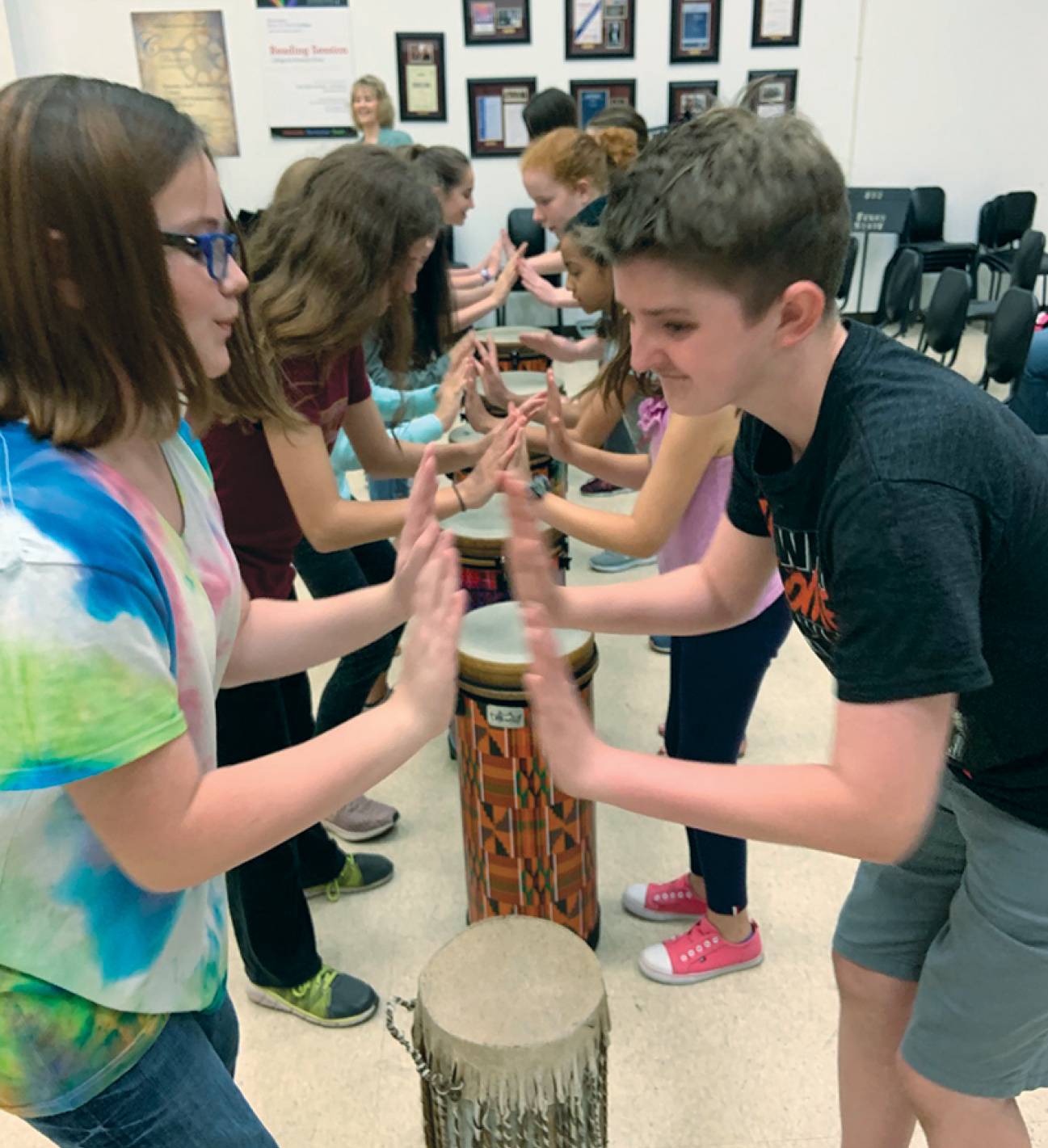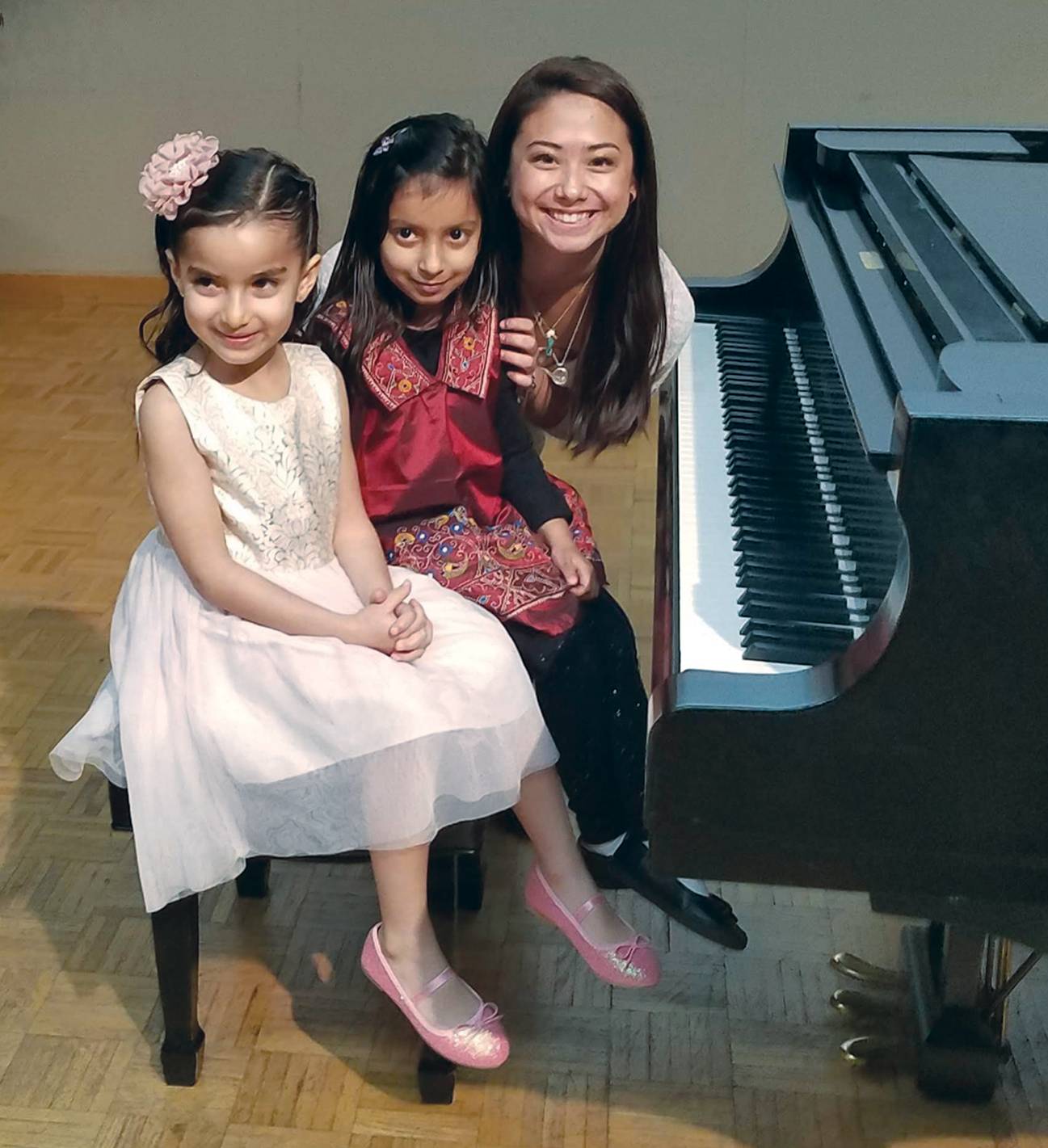
Community outreach program creates a symphony of sound with area youngsters
By Steve Ulfelder
Community outreach programs create a symphony of sound with area youngsters “Fingerboard!” says one student, thrusting her hand in the air. Moments later, another chirps “peg box” and another voice pipes up with “tailpiece.” All earn star stickers for their teams and happiness reigns in the Texas State University School of Music.
The students here are 5 or 6 years old, and they’re competing in a quiz to identify parts of a violin. Enrolled in Texas State’s String Project, they’re using the popular Suzuki method to learn to play the viola or violin. Instruction in cello and bass are also available.
The String Project is just one of the university’s many programs aimed at bringing the joy of music to youth all over Central Texas. Individually, each program is impressive, representing thousands of hours of work. Taken as a whole, Texas State’s commitment to music, education, and the community are truly precious. “This is important to us,” says Dr. Thomas Clark, former director of the School of Music. “This is the kind of music we’re passionate about, important in society and in the world. It’s our mission to advance awareness of and access to this music for children and the larger society.”

Origins of programs
Launched in 2005 by Dr. Lynn Brinckmeyer, professor of music, the Hill Country Youth Chorus was Texas State’s first outreach effort. It was joined in 2006 by Mariachi Infantil, a program spearheaded by John Lopez, professor of music and coordinator of Latin music studies. The String Project came along in 2010, and Dr. Daria Rabotkina, assistant professor of piano, founded the FunKey Piano Project in 2018.
Brinckmeyer started the youth chorus soon after arriving at Texas State, she recalls. “I’d taught in public schools before that,” she says. “It was important to me to continue that, to stay in touch with children.”
Initially, the Hill Country Youth Chorus was a joint project with community leaders; one key mission was and is to support area music programs. Most participants are from the upper elementary grades, but the chorus includes children as young as 6 and as old as 18. The program averages 40 participants per year, though that number has risen as high as 50. Students come from San Marcos, Lockhart, Elgin, Wimberley, Austin, and other school districts — and the chorus, like Texas State’s other youth music programs, also includes home- schooled students.
Educating the educators
Ten years ago, Dr. Ames Asbell, assistant professor of viola, was seeking to bring youth string instrument education to Texas State and applied for a startup grant from the National String Project Consortium, which acts as a clearinghouse to promote both string playing and education for future string teachers. Asbell studied at The University of Texas at Austin and has played with the Austin Symphony Orchestra, Andrea Bocelli, Stevie Wonder, Bonnie Raitt, and David Byrne, among others.
The program offers Wednesday group classes, and each student also receives a weekly 30-minute one-to-one lesson from music education majors who staff the project. “This kind of preparation for the [college] students are irreplaceable,” Asbell says. “They’re making lesson plans; they’re working with the kids. Most of our teachers have four to six individual students. When they graduate, they feel really capable.”
The String Project is for kindergarten through eighth grade, with about 75 participants each year. The program embraces both the Suzuki method, aimed at the youngest beginning students, and traditional orchestral instruction. “That’s a bit unusual and a challenge for our program,” says Rebecca Tast, String Project master teacher and incoming program director. “It’s worth it — we believe the Suzuki method is a great way to get the youngest ones started.”
Honoring dad, paying it forward
Texas State’s Mariachi Infantil has an enchanting origin story. Founded in 2006 by Lopez, its name is an homage to the noted Mexican orphanage mariachi group in which Lopez’s father learned and played.
Lopez launched Mariachi Infantil in response to requests from local parents. “Several parents in the community said, ‘We follow Texas State mariachi; would you consider an off-campus program for our kids?’” With enthusiastic support from Clark and the entire School of Music, Lopez agreed.
It wasn’t always an easy path. “There was a lot we didn’t know in 2006,” Lopez says. “We had to figure things out.” For example, aspects of some instruments
(guitar and trumpet, notably) are simply beyond the physical abilities of younger students. To this day, the curriculum remains a principal challenge for Mariachi Infantil; Lopez and his team must write original music and tweak standards to suit the 30 or so participants.

Russian inspiration
With the FunKey Piano Project, Rabotkina says she was inspired by the programs she grew up on in Russia. “The idea was to keep things as affordable as possible. That music is taken seriously from the very start,” she says.
Participating families must commit to having an instrument in their home before the first lesson. An upright piano is preferred, but an electronic keyboard will do. Parents must accompany their children to the weekly lessons, remain in the
room, and take notes. Rabotkina asks families to devote at least 30 minutes each day to at-home practice. “There is a certain expectation of dedication,” she says.
These high standards have helped make the FunKey Piano Project an immediate hit. Rabotkina, who is assisted by Texas State student teachers, launched it with six students in the fall 2018 semester. That number grew to 12, then 24. Now there’s a 10-student waiting list. Class sizes are restricted to ensure quality.
The importance of the youth music programs to these future teachers can’t be overstated. “Texas State may be one of the largest producers of certified music teachers in the state,” Clark notes. “We certainly have what we think of as the state’s leading program.”
On-the-job training is a vital component. During a String Project lesson, Tast underscores this with gentle suggestions to the student instructors — she unobtrusively points out postures that need correcting and suggests exercises.
“One of the things education majors must develop is a ‘teacher persona.’ There’s no better place to learn this than here,” she says.
More than the sum of its parts
The Texas State faculty who run these outreach programs lean on each other for advice and support. While starting up FunKey, Rabotkina says she got tons of useful advice from Asbell and Dr. Karla Hamelin, who run the String Project. “I pretty much modeled it on the work they’d done already.”
Lopez explains that his talks with the other program leads were often useful. “I appreciate the chance to talk with the other [program leads] about concerts and all the issues and struggles we have in common,” he says. “Things like campus parking, recruitment, and retention.” As an example, he cites Mariachi Infantil’s recent switch from two evening sessions per week to a single longer Saturday session, which was deemed more feasible for students, their families, and instructors.
Meetings and informal discussions also provide an opportunity to plan the many concerts put on by Texas State youth music. Whether it’s the Hill Country Youth Chorus performing at a retirement village, Mariachi Infantil playing at a San Marcos Christmas concert, or a joint recital by the FunKey and String projects, these events are highlights for students, families, audiences, and instructors.
“I just love it when our students get to perform with Texas State students,” Brinckmeyer says. “It gives the kids a chance to stand up there and say, ‘I want to be that when I grow up.’”
There is no shortage of research demonstrating that music is one of the most beneficial activities youth can take part in. Texas State’s youth music programs are good for children, the university’s future teachers, and the broader community. But even more important is a factor that’s harder to quantify.
“Music nourishes our souls,” Asbell says. Paraphrasing famed music teacher Shinichi Suzuki, she says, “We need a beautiful tone, a beautiful heart. A compassionate heart.” ✪